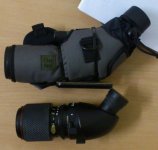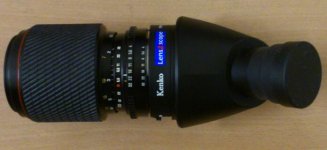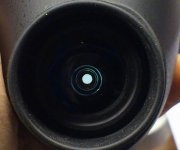looksharp65
Well-known member

This thread is the logical continuation of a previous thread about "Alternative spotting scopes": http://www.birdforum.net/showthread.php?t=242058
Yesterday a Lens2Scope adapter arrived and I have had the opportunity to play with it for a few moments during the day.
I can think of two valid reasons to get a Lens2Scope:
1) You're a bird photographer/wildlife photographer and want to keep the bulk and weight of your equipment as low as possible. Your lens will make a decent scope with the adapter.
2) You want to make a very small spotting scope with what you already have at hand. The company's own website has a 70-200 mm telezoom as an example of how to make a 7-20x spotter.
I'm in the second category, since I'm not into serious bird photography.
Since decades I've owned the very compact Tokina SD 70-210 mm/4-5.6. It is the same size as the contemporary 35-105 mm zooms and used to receive praise for very high image quality. Lately, it has had some revival as a lens for mirrorless digicams, of course with an adapter to make it fit the camera body.
Apart from the lens, I've also owned a telephoto adapter with a straight-through view and TBH, a very poor view with short eye relief and very low image contrast. However, it could demonstrate some of what the Tokina zoom would be able to deliver. When the opportinity to buy the Lens2Scope appeared, I was in.
My taste for exquisite optics has developed into a kind of obsession. I'm not necessarily after aquiring the latest and the greatest, most expensive binoculars and scopes all the time, it's rather value I'm after. So I'm constantly keeping my eyes open for opportunities to put my hands on pre-loved optics.
What's better than finding a bargain-priced alpha of yesteryear in the pawn shop or the advertisement site? Well, best of all would be to discover something completely unknown, revealing a secret nobody ever knew about before. Although there's a plethora of dated optics - and new too! - I'm thinking that this community and some others will make sure there there are no (or nearly none) secrets among the vintage optics.
To put things together out of parts is one way to expand the possibilities for revealing a secret, and I have some ideas for steampunk optics that I mentioned in the other thread.
Buying a Lens2Scope is not actually a radical move into the unknown, but maybe a first step into the wonderful world of experimental optics.
So, how does the Kenko/Tokina reasoning marriage do?
First, since I own the Fieldscope ED50A and the ED82A, anything less will be measured against them. The competition will crush any homemade devices.
These are the prerequisites:
A telephoto lens or a telezoom lens will contain a barlow group to reduce the physical length of the body. The image inversion will be adressed by the 45 degree mirror and the pentaprism of the finder.
A spotting scope contains no built-in barlow group (telephoto group) since the erecting prism also acts to reduce the length of the body.
This means that the lens will have more glass to air surfaces than the scope.
In particular, the complicated construction of a zoom lens will contain many glass to air surfaces. This is the optical train of the Tokina lens:
http://upload.wikimedia.org/wikipedia/en/thumb/a/ab/TokinaSZX70-210text.svg/640px-TokinaSZX70-210text.svg.png
As far as I know, all surfaces are fully multicoated but the number of surfaces will inevitably result in a low transmission rate compared to a spotter.
The aperture of this zoom lens will vary depending on which focal length the zoom is set to operate at. The relative f/ number decreases with increased focal length, but not proportional to the magnification. The real aperture is in fact larger towards the tele end. This means that while the exit pupil will shrink towards the longer FLs, the 3x zoom will not result in an exit pupil with a third of the size of the wide end. My estimation is that the exit pupil size is about 1.8 mm at the tele end, which would correspond to a 37.5 mm aperture, which in turn corresponds nicely to 210/5.6 = 37.5.
So we're talking about daytime optics. By the way, the Lens2Scope can't exceed 2.5 mm exit pupil size regardless of what aperture the lens has.
That means that it can't make use of a relative aperture greater than f/4.0 regardless of focal length.
The Lens2Scope comes with a removable plastic foot with a 1/4" tripod thread.
There are no telephoto lenses that are light and compact enough to make use of this plastic foot since the setup will be way too front heavy.
Luckily, bigger telephoto lenses will provide a built-in mount, making the use of the supplied foot redundant.
The Tokina is a draw zoom, and to zoom in you extend the lens. Focusing and zooming are performed in the same motion and the lens is not parfocal, which means that you will need to refocus when zooming in and out. The focus is also very critical when used at longer distances.
This construction results in two less desirable characteristics:
1) The lens gets more front-heavy once you zoom in so the supplied tripod foot is even more apparently useless. The setup will look down to the earth like a withering tulip.
2) As a result from the above-metioned frontheaviness and the finicky focus, it is easy to lose track of whatever you're looking at.
The Lens2Scope is provided with a soft rubber eyecup of appropriate length to the eye relief. I found myself preferring the calm, relaxed view with the eyecup extended rather than using it with my spectacles.
Now and then I found that the eyepiece is sensitive to eye placement. Blackouts occur. The internal blackening of the eyepiece seems to be fairly poor. Besides seeing some prism edges, there were also two very bright and distinct rings around the (circular) exit pupil. However, they weren't visible when using the Lens2Scope in the intended way.
The Lens2Scope is very lightweight and fairly small, though somewhat larger than I had expected. In particular its width seemed redundantly large, making those "shoulders" the widest part of the setup.
Optically, the combination seems to work very well. The central sharpness is very good and the sweet spot is 100%. Yes, you read right! There is no fall-off of sharpness whatsoever towards the edge, making it equal to the Fieldscope MC II zoom eyepiece. Another very nice finding was the absolute absence of central CA. Near the extreme edges, some CA could be found and I suspect that comes from the eyepiece rather than the lens.
AFOV is 42 degrees according to the manufacturer but didn't feel hopelessly cramped. With the 70-210 mm zoom, this translates to a true FOV between 6 and 2 degrees. Of course the AFOV remains unchanged since the zoom is in the lens, not in the eyepiece.
The pincushion distortion is highly exaggerated and subsequently panning reveals a "rolling bowl". On the other hand, the field is flat which contributes to the excellent edge sharpness.
Colour rendition is slightly warm. Colours don't "pop" like in the Fieldscopes but I have seen quite a few "real" spotters with a considerably worse view.
Apart from the occasional blackouts, the view is quite easy and the subdued brightness contrast and colour contrast contribute to this.
I would not call this scope "dim" since it was perfectly usable, but the small aperture and the fairly low transmission take their tribute somewhere.
I didn't use a sun shield with the setup but found no reflections (ghost images) in the lenses of either part when looking south a sunny day.
At one or two directions, a prism surface would destroy the view but those directions were very limited. This is a lot better than I had expected, considering the great number of lenses involved.
My general judgement about the optics is "barely satisfactory". The bar has been raised too many times and I've looked through too many stellar optics to appreciate the merits of this combo in a fair way.
When I compare the image style with binoculars I have in my possession, I'd say that it is somewhat comparable or similar to the Papilio 6.5x21 or the old Meopta 6x30 porro.
While this is not a substitute for a good compact spotting scope, it holds its own and may be perfectly usable for making some IDs the binocular cannot reach.
The apparent sharpness/edge sharpness and lack of CA together with its tiny dimensions are strong points.
Handling requires some care and I will not make use of the monopod for several reasons - alternative stabilising solutions will be considered.
Will try to post pictures tomorrow.
//L
Yesterday a Lens2Scope adapter arrived and I have had the opportunity to play with it for a few moments during the day.
I can think of two valid reasons to get a Lens2Scope:
1) You're a bird photographer/wildlife photographer and want to keep the bulk and weight of your equipment as low as possible. Your lens will make a decent scope with the adapter.
2) You want to make a very small spotting scope with what you already have at hand. The company's own website has a 70-200 mm telezoom as an example of how to make a 7-20x spotter.
I'm in the second category, since I'm not into serious bird photography.
Since decades I've owned the very compact Tokina SD 70-210 mm/4-5.6. It is the same size as the contemporary 35-105 mm zooms and used to receive praise for very high image quality. Lately, it has had some revival as a lens for mirrorless digicams, of course with an adapter to make it fit the camera body.
Apart from the lens, I've also owned a telephoto adapter with a straight-through view and TBH, a very poor view with short eye relief and very low image contrast. However, it could demonstrate some of what the Tokina zoom would be able to deliver. When the opportinity to buy the Lens2Scope appeared, I was in.
My taste for exquisite optics has developed into a kind of obsession. I'm not necessarily after aquiring the latest and the greatest, most expensive binoculars and scopes all the time, it's rather value I'm after. So I'm constantly keeping my eyes open for opportunities to put my hands on pre-loved optics.
What's better than finding a bargain-priced alpha of yesteryear in the pawn shop or the advertisement site? Well, best of all would be to discover something completely unknown, revealing a secret nobody ever knew about before. Although there's a plethora of dated optics - and new too! - I'm thinking that this community and some others will make sure there there are no (or nearly none) secrets among the vintage optics.
To put things together out of parts is one way to expand the possibilities for revealing a secret, and I have some ideas for steampunk optics that I mentioned in the other thread.
Buying a Lens2Scope is not actually a radical move into the unknown, but maybe a first step into the wonderful world of experimental optics.
So, how does the Kenko/Tokina reasoning marriage do?
First, since I own the Fieldscope ED50A and the ED82A, anything less will be measured against them. The competition will crush any homemade devices.
These are the prerequisites:
A telephoto lens or a telezoom lens will contain a barlow group to reduce the physical length of the body. The image inversion will be adressed by the 45 degree mirror and the pentaprism of the finder.
A spotting scope contains no built-in barlow group (telephoto group) since the erecting prism also acts to reduce the length of the body.
This means that the lens will have more glass to air surfaces than the scope.
In particular, the complicated construction of a zoom lens will contain many glass to air surfaces. This is the optical train of the Tokina lens:
http://upload.wikimedia.org/wikipedia/en/thumb/a/ab/TokinaSZX70-210text.svg/640px-TokinaSZX70-210text.svg.png
As far as I know, all surfaces are fully multicoated but the number of surfaces will inevitably result in a low transmission rate compared to a spotter.
The aperture of this zoom lens will vary depending on which focal length the zoom is set to operate at. The relative f/ number decreases with increased focal length, but not proportional to the magnification. The real aperture is in fact larger towards the tele end. This means that while the exit pupil will shrink towards the longer FLs, the 3x zoom will not result in an exit pupil with a third of the size of the wide end. My estimation is that the exit pupil size is about 1.8 mm at the tele end, which would correspond to a 37.5 mm aperture, which in turn corresponds nicely to 210/5.6 = 37.5.
So we're talking about daytime optics. By the way, the Lens2Scope can't exceed 2.5 mm exit pupil size regardless of what aperture the lens has.
That means that it can't make use of a relative aperture greater than f/4.0 regardless of focal length.
The Lens2Scope comes with a removable plastic foot with a 1/4" tripod thread.
There are no telephoto lenses that are light and compact enough to make use of this plastic foot since the setup will be way too front heavy.
Luckily, bigger telephoto lenses will provide a built-in mount, making the use of the supplied foot redundant.
The Tokina is a draw zoom, and to zoom in you extend the lens. Focusing and zooming are performed in the same motion and the lens is not parfocal, which means that you will need to refocus when zooming in and out. The focus is also very critical when used at longer distances.
This construction results in two less desirable characteristics:
1) The lens gets more front-heavy once you zoom in so the supplied tripod foot is even more apparently useless. The setup will look down to the earth like a withering tulip.
2) As a result from the above-metioned frontheaviness and the finicky focus, it is easy to lose track of whatever you're looking at.
The Lens2Scope is provided with a soft rubber eyecup of appropriate length to the eye relief. I found myself preferring the calm, relaxed view with the eyecup extended rather than using it with my spectacles.
Now and then I found that the eyepiece is sensitive to eye placement. Blackouts occur. The internal blackening of the eyepiece seems to be fairly poor. Besides seeing some prism edges, there were also two very bright and distinct rings around the (circular) exit pupil. However, they weren't visible when using the Lens2Scope in the intended way.
The Lens2Scope is very lightweight and fairly small, though somewhat larger than I had expected. In particular its width seemed redundantly large, making those "shoulders" the widest part of the setup.
Optically, the combination seems to work very well. The central sharpness is very good and the sweet spot is 100%. Yes, you read right! There is no fall-off of sharpness whatsoever towards the edge, making it equal to the Fieldscope MC II zoom eyepiece. Another very nice finding was the absolute absence of central CA. Near the extreme edges, some CA could be found and I suspect that comes from the eyepiece rather than the lens.
AFOV is 42 degrees according to the manufacturer but didn't feel hopelessly cramped. With the 70-210 mm zoom, this translates to a true FOV between 6 and 2 degrees. Of course the AFOV remains unchanged since the zoom is in the lens, not in the eyepiece.
The pincushion distortion is highly exaggerated and subsequently panning reveals a "rolling bowl". On the other hand, the field is flat which contributes to the excellent edge sharpness.
Colour rendition is slightly warm. Colours don't "pop" like in the Fieldscopes but I have seen quite a few "real" spotters with a considerably worse view.
Apart from the occasional blackouts, the view is quite easy and the subdued brightness contrast and colour contrast contribute to this.
I would not call this scope "dim" since it was perfectly usable, but the small aperture and the fairly low transmission take their tribute somewhere.
I didn't use a sun shield with the setup but found no reflections (ghost images) in the lenses of either part when looking south a sunny day.
At one or two directions, a prism surface would destroy the view but those directions were very limited. This is a lot better than I had expected, considering the great number of lenses involved.
My general judgement about the optics is "barely satisfactory". The bar has been raised too many times and I've looked through too many stellar optics to appreciate the merits of this combo in a fair way.
When I compare the image style with binoculars I have in my possession, I'd say that it is somewhat comparable or similar to the Papilio 6.5x21 or the old Meopta 6x30 porro.
While this is not a substitute for a good compact spotting scope, it holds its own and may be perfectly usable for making some IDs the binocular cannot reach.
The apparent sharpness/edge sharpness and lack of CA together with its tiny dimensions are strong points.
Handling requires some care and I will not make use of the monopod for several reasons - alternative stabilising solutions will be considered.
Will try to post pictures tomorrow.
//L
Last edited:






